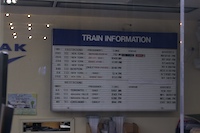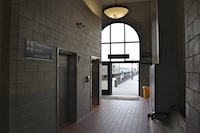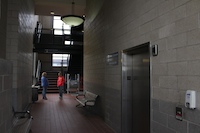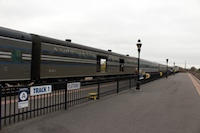


 Rome, NY Rome, NY | Empire Service | Amsterdam, NY  |
| Maple Leaf | ||
 Syracuse, NY Syracuse, NY | Lake Shore Limited | Schenectady, NY  |
Utica-Union Station opened on May 24, 1914 and has seen train service ever since. It is a large Beaux Art train terminal designed by Allen H. Stemx and Alfred Fellheimer of New York City, the same architects as Grand Central Terminal and the station is in the same grand-terminal style. It a granite, brick, and limestone building three stories tall. The depot is the one restored gem of a station (along with Rome that is a much smaller counterpart) along the Water Level Route north of the historic station in Hudson. All the other stations are 1970s AmStations or more modern. The station is still a Union Station since both Amtrak and the Adirondack Scenic Railroad. Amtrak service is provided by all four of the daily trains on the Water Level Route; the two extended Empire Service Trains, the Maple Leaf and the Lake Shore Limited. The Lake Shore Limited also has Baggage service (with the agents using a simple hand cart). In 1980, special trains departed the station to the Lake Placid Winter Olympics in the Adirondacks, the other end of the wilderness Line into Mountains. Train service to the Adirondacks was soon discontinued until 1992 when a dedicated group of Volunteers began operating the Adirondack Centennial Railroad only 4 miles from Thendara south. In the mid-1990s the Adirondack Scenic Railroad restored service all the way south to Utica (using the freight railroad of the Mohawk, Adirondack & Northern to Snow Junction to reach the State Owned railroad tracks of the scenic railway) and it now runs a full seasonal excursion schedule to and from Thendara (Old Forge) and Big Moose two to four times a week entirely run by volunteers.
The station was deteriorating in the 1970s when Oneida County purchased the station from the bankrupt PennCentral (who's trains were taken over by Conrail in 1976) and began restoring the station starting in 1977 in time for the 1980 Olympics. One of the main reasons the station was saved was the upper story offices contained important switching control offices for Conrail and by restoring the station it kept a hundred jobs in Utica. These switching functions have since moved out but a 1997 renovation converted the former railroad office space into civic use as offices for Oneida County and Greyhound and other Intercity Bus lines moved in dubbing the new station the Utica Boehlert Transportation Center.
The grand three-story station (the top two stories form a square with a central open air shaft to allow skylights into the main waiting room) is located along Main Street parallel to the tracks with a grand street entrance marked by columns, a wide glass awning above the main entrance, and clock at the top of the building along with stone Eagles. On each side of the depot (that is away from the tracks) is bound by Railroad Street and 1 Street are secondary entrances with awnings. Attached to the east side of the depot is a long and narrow abandoned single story building. This is the former freight house and runs all the way to 2 Street. The entire exterior of the structure is clad in light colored bricks.
The real beauty isn't found until stepping inside. Here is the grand hall of the station. In the middle is 47 foot high vaulted ceiling with little circular indentations in the arch like those found in Washington's Union Station. Skylights and windows let some natural light into this area and the surrounding waiting room. At the street end of this central area is where the original ticket windows were, although Amtrak has moved. Ticket is still etched above the windows housing a cafe. At the opposite end is 'To Trains' and still where access to the platforms is albeit in a modern, modified way. On each side of this central area, past a line of marble pillars, are the station's wooden benches (with no signs saying waiting for ticketed passengers only) These have seating on all four sides of the central back-rest area with the wooden seat bottoms forming semicircles at each end. The top of the benches are clad in marble on top and heat is provided built directly in the benches as part of the original design.
Offices dot the exterior walls of waiting area. Slightly ironically this includes the offices of the New York State DMV's Oneida County Branch at the SW corner opposite side from the Amtrak ticket window. There waiting and line-up area extends into the main waiting room surrounded by modern but tasteful looking wooden furniture. Other tenants include a restaurant, the offices of the Oneida County Public Market that is behind Union Station in front of the freight house, and a barbershop. The barbershop is note worthy because I believe it has been in continuous operation since the station opened in 1914. There is also a ticket office for Greyhound and other Trailways bus lines whose buses stop right outside the station, there is a small sign at the entrance. Amtrak and the Adirondack Scenic Railway have separate ticket offices. The Adirondack Scenic Railway is at the SE corner of the building and tickets are purchased in what feels like an office (not a real window) about as far away from their trains as possible. Amtrak's small Ticket office is as close to the tracks as possible at the NW corner of the building. For Amtrak there are two windows covered in Marble with modern signs that have the new Amtrak logo above 1980s text (like in an AmStation) that says tickets. The other window probably once said baggage, its above the baggage slot, but there is now a modern LED departure sign (room for the next four trains). In front of the ticket office is a single QuikTrak Machine.
The station tracks and platforms have been vastly reduced since the hay day of the station. Today there is a wide area of separation between the station and actual station tracks that begin with their western ends at the station and run east. The freight house that runs parallel to the station now has a roadway and narrow parking lot between it and the current tracks. It is in this narrow parking lot that the farmers market occurs on Saturdays. Today there are just two tracks used by Amtrak Trains, 1 and 2, on the two Main Line tracks used by CSX Freight Trains with low-level platforms. Plenty of space is between these two tracks (along with a fence). A third track, simply labeled Adirondack RR shares an island platform with Track 1 and is farthest away from the station, nicely located so its excursion trains can operate completely separated and never have to cross the busy CSX Main Line Amtrak uses.
Track 1 is closest to the depot (although there is the roadway and some grass between the depot and platform) and has not been rebuilt. It still has an original iron canopy structure covering most of the platform. The edge of this platform is in poor shape with a simple yellow safety line. The platform is long enough that the entire Lake Shore Limited can stop and open any door it chooses. The eastern end of the train though is beyond the end of the canopy structure where the platform is even more deteriorated but still has a yellow line and a final black and Plexiglas shelter. Hanging from the canopy are two signs with unique fancy looking red background that say Utica, New York. A chain linked-fence covered in ivy in a small grassy area separates this platform from the adjacent parking lot between the platform and abandoned freight building. Gaps in the fence restrict entry to its southern end besides the depot.
Track 1 and the Adirondack Scenic RR (that's what signs say, not track 3) share a modernized with a tactile warning strip island platform. This platform is quite wide and running down the middle of it is a fence designed to separate Amtrak from the scenic railway. There are some modern blue background Utica signs with arrows and the directions of travel to Buffalo and New York City/Boston beneath.
To leave the Track 2 and Adirondack RR platform at the southern end of the island platform is a modern quite large brick structure. Inside is a small enclosed waiting area with a bench, cinderblock walls and two elevators plus a staircase up to the upper story. These lead up to an extremely high glass pedestrian bridge across CSX tracks 1 and 2 (high enough to allow double-stacks to pass underneath with plenty of clearance) to another building modern building that begins just beyond the platform for Track 2 (the end of its platform) and connects directly to the historic station building. There is a staircase directly from the overpass down alongside to track 2 with doors out to the track and corridors both at the first and second levels directly into the historic station house. Passengers entering the historic station house from the second level have a staircase directly down to street level while a corridor leads to the two elevators that serve dual uses for both railroad passengers and the offices of the variety of county services housed in the building. At the upper elevator landing Amtrak (its blue with white text) has an amusing sign that says TRACK 1, Adirondack RR, Probation (one direction, the probation off is on the second floor) and Public Defender the other direction. The lower story of this overpass area is a hall of pretty much wasted space. It arrives in the station by a closed off ramp near across from the first staircase and lower elevator landing that I assume led to the underpass that originally connected the various station platforms. Doors lead into the center of the main central hall in the middle of the station beneath text that says To Trains.
Finally, surrounding the station is a number of historic railroad cars. The Adirondack Scenic railway has a number of its cars (plus its main train to Thendara and Big Moose when its laying over) scattered on a few sidings around the station including a historic caboose and burned out Metro-North FL9. Directly south of the overpass structure at the southern end of Platform 2 is a historic ex-New York Central 0-6-0 Steam Locomotive #6721. This Alco Locomotive was built in 1913. There is also Utica Children's Museum across the street from the station and it has Adirondack #25 a RSC-2 from the 1940s, Budd Santa Fe Dining Car #1479, and a Pennsylvania Railroad Caboose.
Photos 1-50 taken on 5 October, 2013, 51-130: 7 October, 2013



